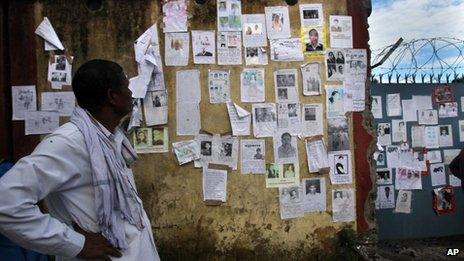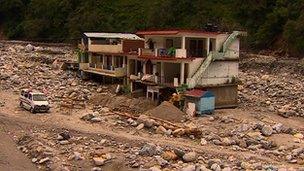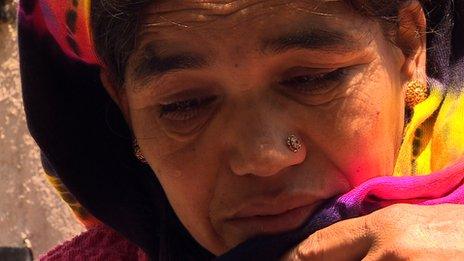India floods: Coming to terms with loss in Uttarakhand
- Published

A month after the floods hit Uttarakhand, thousands of people are still missing
Nearly a month after floods and landslides devastated the northern Indian state of Uttarakhand, thousands of people still missing will now be presumed dead. As the scale of the tragedy unfolds, many families are coming to terms with the fact that they may never know what happened to their loved ones. The BBC's Yogita Limaye reports from Uttarakhand.
Vasundhara Devi last spoke to her younger son Sanjeev on 16 June. He was in the Hindu temple town of Kedarnath with his father and 17-year-old brother Rajeev.
Vasundhara Devi's husband worked as a priest in Kedarnath for half the year and their two children were visiting him during school holidays.
Sanjeev told his mother that it had been raining heavily in the town and that all of them were huddled inside the temple with hundreds of pilgrims. He promised to call her the next day.
The call never came.
"I tried asking those who survived, who escaped the floods if they had seen my family. But no-one had. I have no hope they will return now. I've nothing to live for anymore. If someone gives me poison, I'll take it," she says.
Vasundhara Devi's village Devli Bhanigram is about 50km (31 miles) from Kedarnath. Here, 54 people have lost their lives. All of them were men and most were the only earning members of their families.
Most men from villages around Kedarnath work there for six months of the year, leaving their families behind.
On 17 June, a glacial lake above the town burst after days of heavy rainfall. A surge of water carrying stones and boulders ravaged the temple town and washed away everything in its path.
Those who survived are eager to tell the stories of the horrors they have seen.
"I was swept away by the water, but a lady held my jacket and pulled me up. I saw people being sucked into whirlpools, I knew many of them but I was helpless. I had no strength to save them," says Santosh Tiwari.
'Going to die'
Krishna Purohit, an engineering student was in Kedarnath with his father and brother when disaster struck. His father used to run a small shop there.
"Water surged into our house and although we were clinging on to the ceiling, it was up to our necks. We thought we were going to die. My father told us to close our eyes and pray. Then the back wall of our house broke and the water receded," he says.
Krishna and his family were rescued after four days.

Sonprayag town is all but reduced to rubble
The trail of destruction went beyond Kedarnath.
Sonprayag, a town less than 20km (12 miles) away, is all but reduced to rubble.
It was a stop for the hundreds of thousands of pilgrims who visited Kedarnath every year. Hotels and shops used to be full of people. Now, they are full of silt left behind by the river.
On the walls and doors of the buildings still standing, people who came here after the disaster have put up photos of their family members who are still missing.
Just ahead of Sonprayag, on the route to Kedarnath, the mountain has literally come down on what used to be a motorable road.
The temple town is now virtually cut off after this point.
Searching for loved ones
Although the army has been building a makeshift road, it is dangerous to try crossing it.
But people have been still attempting to climb the treacherous mountains in search of their loved ones.
Ramesh Lal has tried to trek beyond Sonprayag several times but has always had to turn back. He is looking for his nephew. Lal himself survived the floods.

Vasundhara Devi has given up hope that her husband or two sons will every return
"I ran for miles up the mountains to save myself. I've seen dead bodies strewn all over, trapped under trees, stuck in the mud and floating in the water. Those who haven't been here may harbour some hope that some of those missing may return, but after what I have seen, I know there can be no survivors," he says.
According to the state government, more than 5,000 people are missing. Less than 1,000 of these are from Uttarakhand, while the rest are pilgrims from other states. They will all be presumed dead now.
The army has had to cremate many of those who have died, in the places they were found because it was impossible to airlift all of them. DNA samples have been collected so that they can be identified later.
In this difficult terrain, there are new landslides every day and access to the affected areas is limited.
A month since the floods, estimates of casualties have been changing rapidly and the local government has had to admit that the true scale of this tragedy may never be known.
- Published28 June 2013
- Published2 July 2013
- Published27 June 2013
- Published24 June 2013
- Published20 June 2013
- Published25 June 2013
- Published22 June 2013